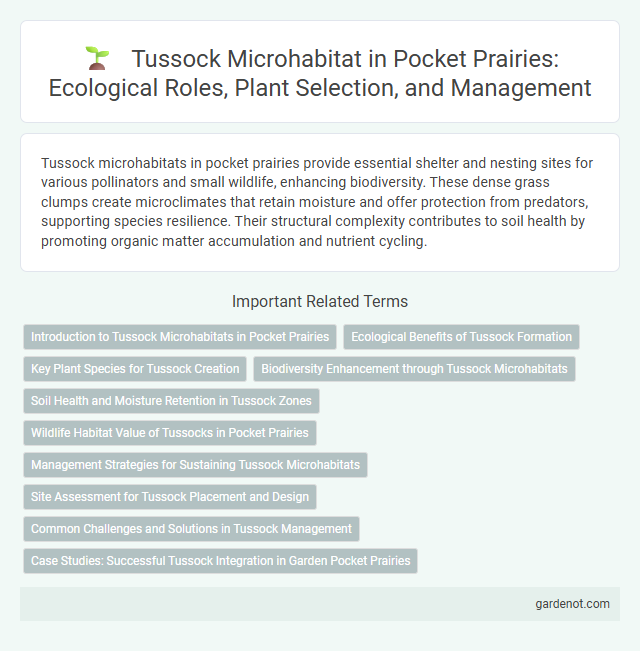Tussock microhabitats in pocket prairies provide essential shelter and nesting sites for various pollinators and small wildlife, enhancing biodiversity. These dense grass clumps create microclimates that retain moisture and offer protection from predators, supporting species resilience. Their structural complexity contributes to soil health by promoting organic matter accumulation and nutrient cycling.
Introduction to Tussock Microhabitats in Pocket Prairies
Tussock microhabitats in pocket prairies create dense clumps of grasses that offer essential shelter and foraging opportunities for diverse insect and small vertebrate species. These structures enhance biodiversity by providing microclimatic stability, moisture retention, and protection from predators. Incorporating tussock-forming grasses in pocket prairie designs supports ecological resilience and promotes habitat complexity within urban landscapes.
Ecological Benefits of Tussock Formation
Tussock microhabitats in pocket prairies create unique ecological niches that support diverse insect and bird populations by providing shelter and food resources. These dense grass clumps enhance soil stability and moisture retention, promoting healthier microbial communities and nutrient cycling. Their structural complexity fosters increased biodiversity and resilience within prairie ecosystems.
Key Plant Species for Tussock Creation
Key plant species for tussock creation in pocket prairies include native grasses such as Little Bluestem (Schizachyrium scoparium), Big Bluestem (Andropogon gerardii), and Switchgrass (Panicum virgatum), which develop dense clumps essential for microhabitat formation. These species facilitate soil stabilization, moisture retention, and provide shelter for invertebrates and small wildlife, enhancing biodiversity. Establishing such tussock-forming plants supports complex ecological interactions critical to pocket prairie resilience.
Biodiversity Enhancement through Tussock Microhabitats
Tussock microhabitats within pocket prairies significantly enhance biodiversity by providing shelter, nesting sites, and foraging opportunities for a variety of invertebrates, birds, and small mammals. These dense, tufted grass structures create microclimatic conditions that support diverse plant and animal species, fostering ecological complexity. By maintaining structural heterogeneity, tussocks contribute to increased species richness and ecosystem resilience in restored prairie environments.
Soil Health and Moisture Retention in Tussock Zones
Tussock microhabitats within pocket prairies significantly enhance soil health by promoting organic matter accumulation and fostering diverse microbial communities. These densely packed grass clumps improve moisture retention through their extensive root systems, which reduce evaporation and increase water infiltration. The enhanced soil structure in tussock zones supports nutrient cycling and resilience against drought conditions.
Wildlife Habitat Value of Tussocks in Pocket Prairies
Tussocks in pocket prairies create essential microhabitats that support diverse wildlife by offering shelter, nesting sites, and food resources for insects, small mammals, and ground-nesting birds. These dense grass clumps enhance biodiversity by maintaining soil moisture and temperature regulation, which benefits native pollinators and detritivores. The structural complexity of tussocks fosters a refuge from predators and harsh weather conditions, making them critical components of sustainable urban prairie ecosystems.
Management Strategies for Sustaining Tussock Microhabitats
Effective management strategies for sustaining tussock microhabitats in pocket prairies include controlled burning, selective mowing, and invasive species removal to maintain structural complexity and native plant diversity. Prescribed fire regimes promote tussock growth by reducing woody encroachment and nutrient buildup, which supports habitat for specialized fauna such as certain grassland birds and pollinators. Monitoring soil moisture and adjusting grazing intensity further preserve the microclimatic conditions essential for tussock persistence and ecosystem resilience.
Site Assessment for Tussock Placement and Design
Site assessment for tussock microhabitat placement involves evaluating soil moisture, sunlight exposure, and existing vegetation to ensure optimal growth conditions within a pocket prairie. Detailed analysis of topography and drainage patterns guides the strategic positioning of tussocks to enhance biodiversity and provide shelter for pollinators and small fauna. Incorporating soil composition and local climate data further refines tussock design for sustainable ecosystem integration.
Common Challenges and Solutions in Tussock Management
Tussock microhabitats in pocket prairies often face challenges such as invasive species infiltration, soil compaction, and uneven moisture retention. Effective tussock management includes targeted invasive plant removal, strategic mowing or controlled burns to maintain tussock structure, and soil aeration techniques to improve root health. Implementing adaptive management plans that monitor tussock growth and environmental changes enhances ecosystem resilience and biodiversity within the pocket prairie.
Case Studies: Successful Tussock Integration in Garden Pocket Prairies
Case studies of successful tussock integration in garden pocket prairies highlight increased biodiversity and enhanced pollinator habitats. Tussock grasses such as Andropogon gerardii and Sporobolus heterolepis provide essential microhabitats that support beneficial insects and small vertebrates. These microhabitats improve soil health by preventing erosion and promoting moisture retention, key factors in sustainable urban prairie restoration.
Tussock microhabitat Infographic

 gardenot.com
gardenot.com